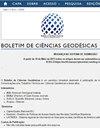THE INFLUENCE OF FLIGHT CONFIGURATION, CAMERA CALIBRATION, AND GROUND CONTROL POINTS FOR DIGITAL TERRAIN MODEL AND ORTHOMOSAIC GENERATION USING UNMANNED AERIAL VEHICLES IMAGERY
IF 0.5
Q3 Earth and Planetary Sciences
引用次数: 5
Abstract
Abstract: Technological improvement in sensors and the use of computer vision algorithms made possible the generation of high accuracy mapping products (cm level) using data acquired by low-cost Unmanned Aerial Vehicles (UAV). However, the procedure to optimally set the aerial block configuration is not well understood for some users mainly due to the popularization of the UAV and its use by non-specialists. This study aims to contribute to this aspect, investigating and highlighting the influence of flight parameters, camera calibration and number of Ground Control Points (GCP) on generating digital terrain models and orthomosaic. To address this issue, several field experiments and data processing were carried out. The quality was assessed by calculating the Root Mean Square Error (RMSE) together with a bias evaluation (t-Student test at 90% confidence level). The results suggest that an optimum block configuration for accurate and unbiased products is achieved by surveying at rates of 80%/60% (forward and sidelap, respectively), with an average Ground Sample Distance (GSD) of around 1 cm at a flight height of 31 m, using a pre-calibrated camera and 5 GCP at least.飞行配置、相机校准和地面控制点对使用无人机图像的数字地形模型和正射影生成的影响
摘要:传感器的技术进步和计算机视觉算法的使用使利用低成本无人机获取的数据生成高精度地图产品(厘米级)成为可能。然而,由于无人机的普及和非专业人员的使用,一些用户对优化设置空中拦截配置的程序并不了解。本研究旨在为这一方面做出贡献,调查并强调飞行参数、相机校准和地面控制点(GCP)数量对生成数字地形模型和正交镶嵌的影响。为了解决这个问题,进行了几个现场实验和数据处理。通过计算均方根误差(RMSE)和偏差评估(90%置信水平下的t-学生检验)来评估质量。结果表明,通过使用预先校准的相机和至少5个GCP,以80%/60%的速率(分别为前搭接和侧搭接)进行测量,在31米的飞行高度下,平均地面样本距离(GSD)约为1厘米,可以实现精确和无偏产品的最佳块配置。
本文章由计算机程序翻译,如有差异,请以英文原文为准。
求助全文
约1分钟内获得全文
求助全文
来源期刊

Boletim De Ciencias Geodesicas
Earth and Planetary Sciences-General Earth and Planetary Sciences
CiteScore
1.70
自引率
20.00%
发文量
10
审稿时长
3 months
期刊介绍:
The Boletim de Ciências Geodésicas publishes original papers in the area of Geodetic Sciences and correlated ones (Geodesy, Photogrammetry and Remote Sensing, Cartography and Geographic Information Systems).
Submitted articles must be unpublished, and should not be under consideration for publication in any other journal. Previous publication of the paper in conference proceedings would not violate the originality requirements. Articles must be written preferably in English language.
 求助内容:
求助内容: 应助结果提醒方式:
应助结果提醒方式:


